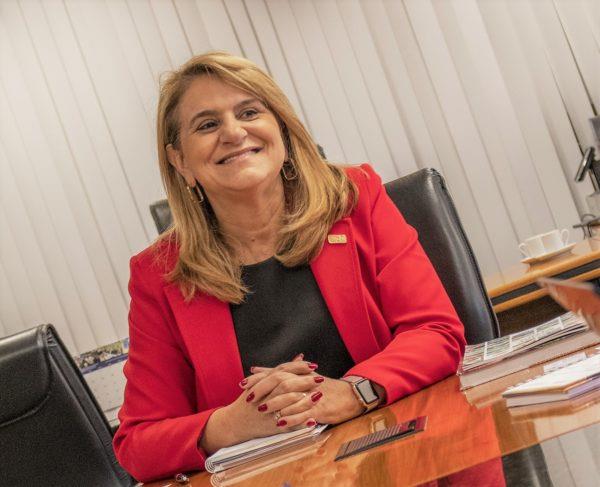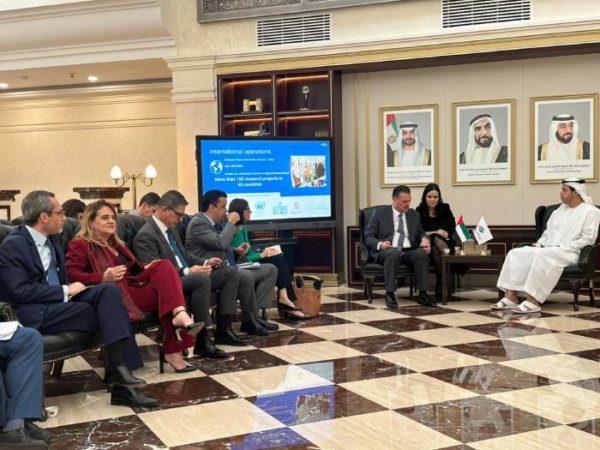(MENAFN- Brazil-Arab News Agency (ANBA))

São Paulo – At a time when the whole world turns to new technologies and its potential uses, one of the world's leading food research institutions, Brazil's agricultural research agency Embrapa, makes history. Career researcher, software engineer and PhD in artificial intelligence, Silvia Massruhá became the president of Embrapa last May as the first woman to ever take the role since the agency was founded in 1973.
Few months into the role, Massruhá has already visited Arab countries, where she noticed a high need for cooperation in food security, and she is aware of the crucial importance of Brazil for the global agriculture.
Sustainability projects are some of the priorities of her administration in the following four years at Embrapa, but the experience she amassed in technology will also be key in her leadership. Massruhá wants more traceability in farming, and the productive and digital inclusion of the Brazilian small and midsized farmer.
She spoke of these in an exclusive interview with ANBA.
Professional career
Massruhá has studied in the Pontifical Catholic University of Campinas, São Paulo state's Unicamp university Unicamp, and Brazilian space research agency INPE, and she started her professional career at Embrapa in 1989 together with the first team of researchers hired by the corporation.
“I've been at Embrapa for 34 years. Back then, they were already thinking about hiring not only veterinarians, agronomists and zootechnicians but also people from exact sciences like computer sciences, electrical engineering, mathematics, statistics, physics, to figure out a way to work in a multidisciplinary manner to help solve the farming problems. [Embrapa] was far-sighted back then, as it already had this kind of professional and researcher teamm working side by side with agronomists and veterinarians,” she told ANBA.

The priorities of the president include sustainability and digital inclusion
At the time, the Embrapa Informática Agropecuária, now called Embrapa Agricultura Digital , was established in Campinas. Massruhá has worked there her entire life, then moved to Brasília to take over as president.
“I've always worked in computer science. My master's was on dairy herd improvement and farm management, while my PhD dealt with AI twenty years ago – everyone is talking about it now, but it was quite disruptive at the time. I focused on plant disease diagnostics using AI,” she said.
At Embrapa Agricultura Digital, Massruhá coordinated projects in the variscope areas of the 43 units of Embrapa, including Embrapa Pantanal, where a sustainability index was created by using AI at the Fazenda Pantaneira Sustentável.“They had different indexes for the three dimensions – economic, environmental and social – so I worked to combine them in an app for the farmer to know where there's room for improvement,” she said.
From 2015 to 2022, Massruhá was the head of Embrapa Agricultura Digital.“In the thematic units [like Agricultura Digital], we have the chance to work in partnership with 42 other units, so I got to understand how digital technology could be important to add value to production systems, regardless of the productive chain itself,” she said.
Shortly before she became president, Massruhá worked as the researcher in charge of the project of Center of Science for Development in Digital Agriculture (CCD-AD/SemeAr), a partnership with São Paulo state government's research foundation Fapesp aiming to create ten technological districts across Brazil to foster digital technology for the small and midsized farmer .
Presidency of Embrapa
Silvia Massruhá spoke of the invitation to take on the challenge to become the president of Embrapa.“It's a great honor for me because Embrapa's career researchers like me have a great passion for what we do, since our research can help put the food on the table of people, which is so rewarding,” she said.

Massruhá signs the presidency book of Embrapa besides its chairman Guilherme Soria
She knows that she took on a very big responsibility on the occasion of the 50th anniversary of Embrapa.“It was established to ensure the food security of our country, as back then [in the 1970s], we imported 30% of our food,” she said. The work was focused on developing technologies and adapting agriculture to the tropical climate. This was also done later with respect to Cerrado and other Brazilian biomes.
The situation is now different. Brazil stands now as a major food producer and exporter to the whole world.“Looking at the world now, we're working with the vision of the agrifood system, centered on food, fibers, energy – all these in an integrated, multidisciplinary manner. There's the matter of growing healthy, nutritifood based on sustainable practices, and sustainability is not only related to the economy but also to the environment and society. So how can we bring these metrics and indexes to sustainability ? That's a challenge, that's the new vision,” she said.
All these are also tied to the nutrition transition , Massruhá said, which includes new diet models, with consumers more concerned with nutrition, health, and the origin of food.“So how can we bring this transparency to the production process? Here comes another term in line with sustainability that's traceability,” she said.
The sustainability metrics and indexes are important at an international level , too.“It has been often questioned whether the Brazilian agriculture is actually sustainable. Over the past 50 years, our agriculture has expanded 140% in area, from 61 million acres of planted area to 161 million acres, up 100 million acres. And productivity has grown 580%, so the production per acre has increased thanks to technology, which is the landmark of our agriculture ,” she said.

Brazilian delegation met with the Ministry of Environment, Water and Agriculture of Saudi Arabia
Being a competitor on the global stage, Massruhá says, it's not enough to say that Brazil's agriculture is sustainable.“ We have to show it with numbers . This is our challenge, helping improve this communication ,” she said.
Traceability has also helped improve communication and the international image.“ If you bring this transparency to the production process, there isn't what to question ,” she pointed out.
Besides sustainability and traceability, Massruhá's third priority in her administration is the social and digital inclusion of the small and midsized farmers which helps them enhance their income, incorporate their business model, and narrow the gap between big farmers and small and midsized farmers.
Public agency
Massruhá pointed out that Embrapa is a public agency affiliated with the Ministry of Agriculture and Livestock of Brazil.“ We must strengthen Embrapa ,” she said. The president said the global leading role that Brazilian agriculture now plays is due precisely to the investments in science and technology and pointed out the people are the most important asset of the research process.
“Just as Embrapa was visionary when hiring people like me in 1989 and sent researchers across the world to bring temperate climate technologies to adapt to our reality in 1973, we now have to hire this new generation To do research, people are the main capital, the human being, the researchers, technicians, analysts, assistants, so this training is needed,” said Massruhá.

Massruhá met with the Abu Dhabi Fund for Development (ADFD)
Another crucial factor for strengthening the state-owned corporation is funding and investment to implement research projects, with investments in infrastructure such as upgrading laboratories.
The president said the new growth acceleration plan, known as PAC , launched by the federal government will have invested by 2026 some BRL 1 billion (USD 200 million) in the infrastructure of Embrapa.“BRL 850 million [USD 174 million] are for 43 research centers, while BRL 145 million [USD 30 million] will be for state research centers that are partners of Embrapa at the National Agricultural Research System (SNPA),” she said.
Embrapa has approximately 1,000 projects , 25% of which are public-private partnerships (PPPs).“We want to ramp up these partnerships, but we also have to improve our PPP business model, as out of these 25%, only 5% is private, which means very little private investment in Embrapa, and the royalty cheque is really small. It's not enough to feed our research. We need a model that's more of a win-win,” she said.
International mission
Figures from the United Nations show that by 2050 the global population will reach 9 billion people, and the global food production is expected to increase by 70%.“It's a matter of peace, as if there's no food, there'll be war. Approximately 40% [of the food produced globally] is expected to come from Brazil,” said Massruhá.
With this huge responsibility for the global food security, the president said a mapping has shown that Brazil has approximately 400 million acres of grazing land, of which approximately 100 million acres with agricultural aptitude are degraded.
“So instead of expanding into new areas to increase the production, we could use these degraded lands, recover these areas by planting or even improving their grazing model, using several technologies by Embrapa like direct planting, bioinputs, crop-livestock-forest,” she said.
Arab countries
In late July, Silvia Massruhá traveled with Agriculture and Livestock minister Carlos Fávaro to Saudi Arabia and the United Arab Emirates , as well as Japan and South Korea. In the two Arab countries, they had meetings with officials from their ministries of Agriculture and Environment, private companies, and investment funds. The project of recovery of degraded grazing lands was presented then.
Massruhá noticed how important the subject of food security was for the Arabs.“Food security is a concern for all Arab countries, which are now very dependent on other countries. They want this partnership with Brazil and see Embrapa as a reference in tropical agriculture and a major partner to help develop their agriculture,” she said.
Other topics discussed were the exchange of researchers to improve agricultural practices, fertilizers and Brazil's reliance on them, the impacts of climate change , and management of natural resources like soil, water and biodiversity.

Massruhá met the UAE's International Cooperation minister Reem Al Hashimy
Potential exchanges in food security and environment were discussed with the governments.“Saudi Arabia showed some interest in the interchange of date growing. We have Embrapa Semiárido in Petrolina (Pernambuco), which has a similar biome. Now it's less active, but we could reactivate it, so it could be a partnership in genetic improvement . There's also a large demand for alfafa growing, which could be an interesting interchange,” she said.
Massruhá also highlighted her visit to the International Center for Biosaline Agriculture (ICBA) in Abu Dhabi, the UAE. Embrapa has been its partner since 2020 . The agreement aims for the development and joint spread of technologies related to the use of salt-rich waters.“We want to rev up this partnership and knowledge interchange,” he said.
Woman at the top
Massruhá acknowledged the relevance of being the first woman to preside over Embrapa. She was also the first female head of Embrapa Agricultura Digital.“Throughout my career I never stopped to reflect much about that. Being a woman has never intimidated me – I've always worked in two male-dominated fields – technology and agronomy, but my fohas always been in education , equipping myself to become a better professional. Education and persistence made a difference in my career, with a clear focus,” said the great-granddaughter of a Lebanese great-grandfather.
Translated by Guilherme Miranda
Supplied
Supplied
LariMorais/Embrapa
Sibelle de Andrande Silva/Embrapa
Supplied
Supplied
The post Embrapa president wants more technology in farming appeared first on Agência de Notícias Brasil-Árabe .